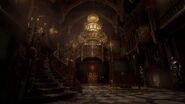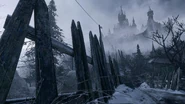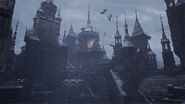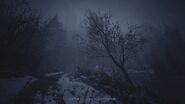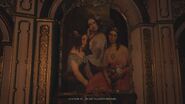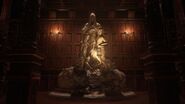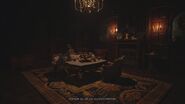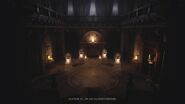(Capcom's primary storyline)
"That place is full of nothing but blood and death!" — Elena about Castle Dimitrescu |
Castle Dimitrescu (ドミトレスク
Overview[]
The castle was built during the 15th century under the watchful eye of Cesare, a Duke, and was later inhabited by his descendants, the noble Dimitrescu family, who instigated a number of violent murders and mutilations against the local peasantry. It is uncertain what became of them in the centuries after, whether they left the village or their main branch became extinct, but by the mid-20th century ownership of the castle fell to Countess Alcina Dimitrescu, who was considered an outsider to the region.[1] Continuing her family's legacy of maintaining a feudal and tyrannical rule over the village, the castle once more became associated with Sanguis Virginis, a brand of enriched red wine whose secret recipe dated back to winemaking techniques developed by the Dimitrescus in the Middle Ages, wherein grapes were infused with the blood of exsanguinated and murdered locals, unbeknownst to the outside world.
Mother Miranda briefly used the castle during her experiments on the nearby villagers with the Cadou parasite; one such experiment birthed Dimitrescu's daughters, Bela, Cassandra and Daniela, who aided the countess in capturing and torturing the villagers to feed on and manufacture their blood into exported wine. In 2021, the castle was largely damaged and eventually abandoned after Ethan Winters killed the Dimitrescu family in his search for his daughter, Rosemary. The following morning the village was destroyed when Winters detonated an N2 explosive, and though much of the forest was consumed by fire, Castle Dimitrescu survived.[2]
Architecture[]
The overall structure of the estate dates back to the European Middle Ages and largely conforms to architectural concepts derived during its High Renaissance period, crafted from stratified limestone comprising the turrets and battlements which adorn the castle's fog-enshrouded towers and snowy balustrades, interconnected by various belfries. The castle's exterior features several scarecrows among the fields, although compared to the traditional scarecrows seen in the village, these scarecrows are the hollowed-out bodies of House Dimitrescu's male victims.
The interior ornamentals of the castle adopt a heavily Baroque style, which came into prominence during the 17th century and suggest the castle may have been updated during that time. Light is intentionally left minimalized to sconces and candelabras throughout the castle, with many windows having been draped in thick curtains, leaving the vast majority of the castle steeped in shadow and secrecy. Its upper echelons are exquisitely decorated, complete with twisting hallways lacquered in ornate golden gildings of vines, expensive furniture, crystal chandeliers, and velvet carpeting lining its checkered marble floors, which extend from its entrance hall, main hall, and the Hall of Four, the sealed entryway to the Dimitrescu's outdoor family crypt, the Tower of Worship. Tall columns and pillars support the high domed ceilings of many chambers and are filled with statues, paintings and crests baring the history of the Dimitrescu bloodline; these consist of the dining room, dressing room, library, atelier, attic, armory, wine room, tasting room, opera hall, bedchamber, the Mistress of the castle's private quarters, and the Tower of Rage. Fireplaces located in several of these rooms are prominent centerpieces for warmth during the castle's harsh winter months, and a means for the castle's denizens to burn the remains of those victimized by them. A courtyard acts as a pathway to specific regions of the castle, among these the Halls of Ablution, Joy, Pleasure, and Sorrow. Per unknown arrangements with the Mistress of the castle, The Duke has secured a room in which to set up his emporium, providing a truce zone between himself and the Lady in which they could conduct private business dealings, and which later allowed him to supply weapons and information to Ethan Winters without her interference.
The castle's lower recesses, by contrast, are heavily decayed from disrepair, and are host to a kitchen, storage basement, distillery, and stone relief carved directly into the walls of the Hall of War; an artistic construct depicting 15th century soldiers during a time of battle, likely a point of reference to the means by which the Dimitrescu nobility first garnered control over the region. This symbolically serves as the only sealed passage to a vaulted dungeon fortified with iron cages, the likes of which are addled with gore left behind from its owners' violent activities on the prisoners contained therein. These dank caverns lead directly to the sealed off catacombs of the Chamber of Solace, where previous victims of the castle now wander endlessly in search of blood, forever trapped in a state worse than death.
Gallery[]
Further notes[]
- In fitting with Resident Evil Village's literary allusions to Bram Stoker's Dracula, the castle is an analogue to Castle Dracula. Both are located in an isolated part of the mountains - the Carpathians in Dracula - and are 15th century constructs.
- The bathtub of blood located in the Hall of Ablution is most likely inspired by legends of Elizabeth Bathory, who was rumored to have bathed in the blood of young women in an attempt to maintain her youth and beauty, although this is largely agreed to be sensationalism by modern scholars.
- The music on the piano within Castle Dimitrescu is Sogno by Francesco Paolo Tosti.
Sources[]
- ↑ Maiden Demo (2021), file: "Winemaking History" (tentative).
- ↑ Resident Evil Village (2021), scene: "Rose".
| ||||||||||||||||||||||||||||


